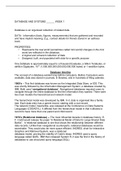DATABASE AND SYSTEMS ______ WEEK 1
Database is an organised collection of related data.
DATA: Information (facts, figures, measurements) that are gathered and recorded
and have implicit meaning. E.g., contact details for friends stored in an address
book.
PROPERTIES:
• Represents the real world (sometimes called mini world) changes in the mini
world are reflected in the database.
• A logical and coherent collection of data
• Designed, built, and populated with data for a specific purpose
One Zettabyte is approximately equal to a thousand Exabytes, a billion Terabytes, or
atrillion Gigabytes. 1021 (1,000,000,000,000,000,000,000 bytes) or 1 sextillion bytes.
Database timeline
The concept of a database existed long before computers. Before Computers were
available, data was stored in journals, in libraries, and in hundreds of filing cabinets.
1960’s – This first database was known as the Integrated Data Store, or IDS. This
was shortly followed by the Information Management System, a database created by
IBM. Both used ‘navigational database’. Navigational databases required users to
navigate through the entire database to find the information they wanted. There were
two main models the hierarchical and network model.
The hierarchical model was developed by IBM. In it, data is organised like a family
tree. Each data entry has a parent record, starting with a root record.
The network model, meanwhile, was released at the Conference on Data Systems
Languages (CODASYL). It differed from the hierarchical model in that it allowed a
record to have more than one parent and child record.
1970’s (Relational database) -- The most influential decade in database history. E.
F. Codd would release his paper “A Relational Model of Data for Large Shared Data
Banks”. A relational database is one that shows the relationship between different
data records. Unlike their navigational counterparts, relational databases would be
searchable. They would also be more space efficient. INGRES, short for Interactive
Graphics and Retrieval System, was a relational
database model, proving the viability of Codd’s ideas. INGRES used a query
language called QUEL. IBM then released System R, it was the first in the history of
databases to use structured query language (SQL).
, 1980’s -- The 1980s in the history of databases marked a time of growth for the
relational database models and earlier models were fading. The 1980s also saw
SQL become the standard language used for databases, which we still use today.
This concept of Object-oriented database management systems (OODBMS)
appeared in the mid-80s. Object databases would view data as ‘objects’. They would
work with programming languages that supported the ‘object-oriented’ approach.
1990s (the internet) – The early days of object-oriented database management
was not popular one. This was partially due to the costs and time it would take to
rewrite existing databases to support the approach. However, object oriented
database systems grow more popular in the 90s.
Another key event impacting the history of databases in the 90s was the creation of
the World Wide Web.
High investments in online businesses fuelled demand for client-server database
systems. As such, the internet helped to power exponential growth of the database
industry in the 1990s. This led to the creation of MySQL in 1995, which was open
source which meant that it provided an alternative to the database systems offered
by big companies like Oracle and Microsoft. MySQL is still used by many today.
2000s (NoSQL) – In 1998, the term NoSQL (not only structured query language)
was coined. It refers to databases that use query language other than SQL to store
and retrieve data. NoSQL databases are useful for unstructured data.
This is a notable development in the history of databases because NoSQL allowed
for faster processing of larger, more varied datasets. NoSQL databases are more
flexible than the traditional relational databases that had risen the decade before.
2010s (cybersecurity) –
The 2010s were a decade of increased data awareness, with the rise of big data and
an increased emphasis on data protection. And these trends naturally inform the
history of databases.
Having earned its name the decade before, big data was a major buzzword of the
2010 — and big data meant big databases to house it. With the need to collect,
organise and make use of such huge reams of data, automation software has
grown a popular tool when interacting with databases.
This is the decade where the value of data truly hit the public consciousness. And,
with it, the importance of keeping data safe. Legislation like GDPR and the NIS
directive only served to further highlight the importance of keeping data well
protected and secure.
Alongside this is the impact of globalisation on the evolution of databases, with more
attention going to distributed databases. These are databases that store data across
multiple physical locations, rather than in one place.




